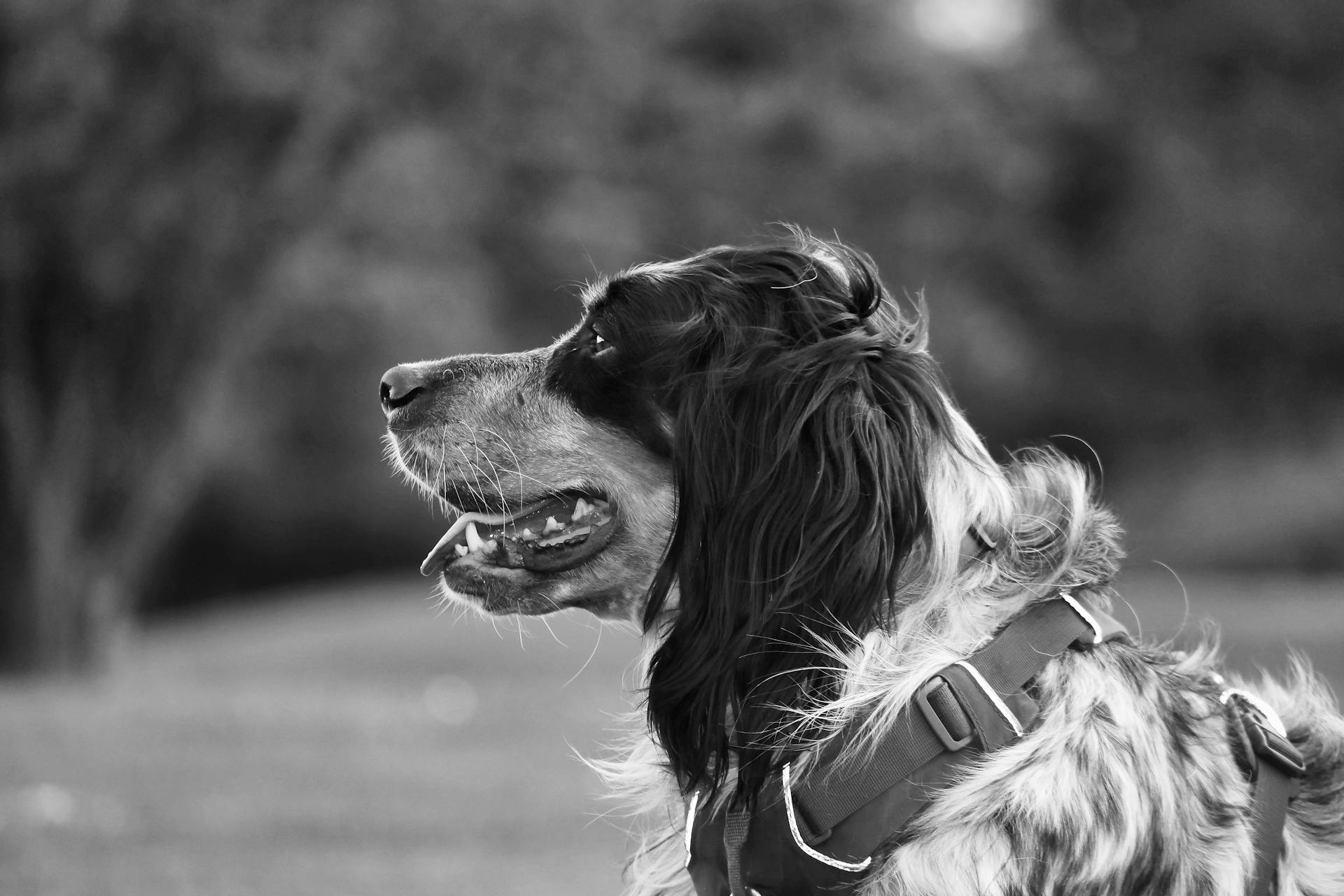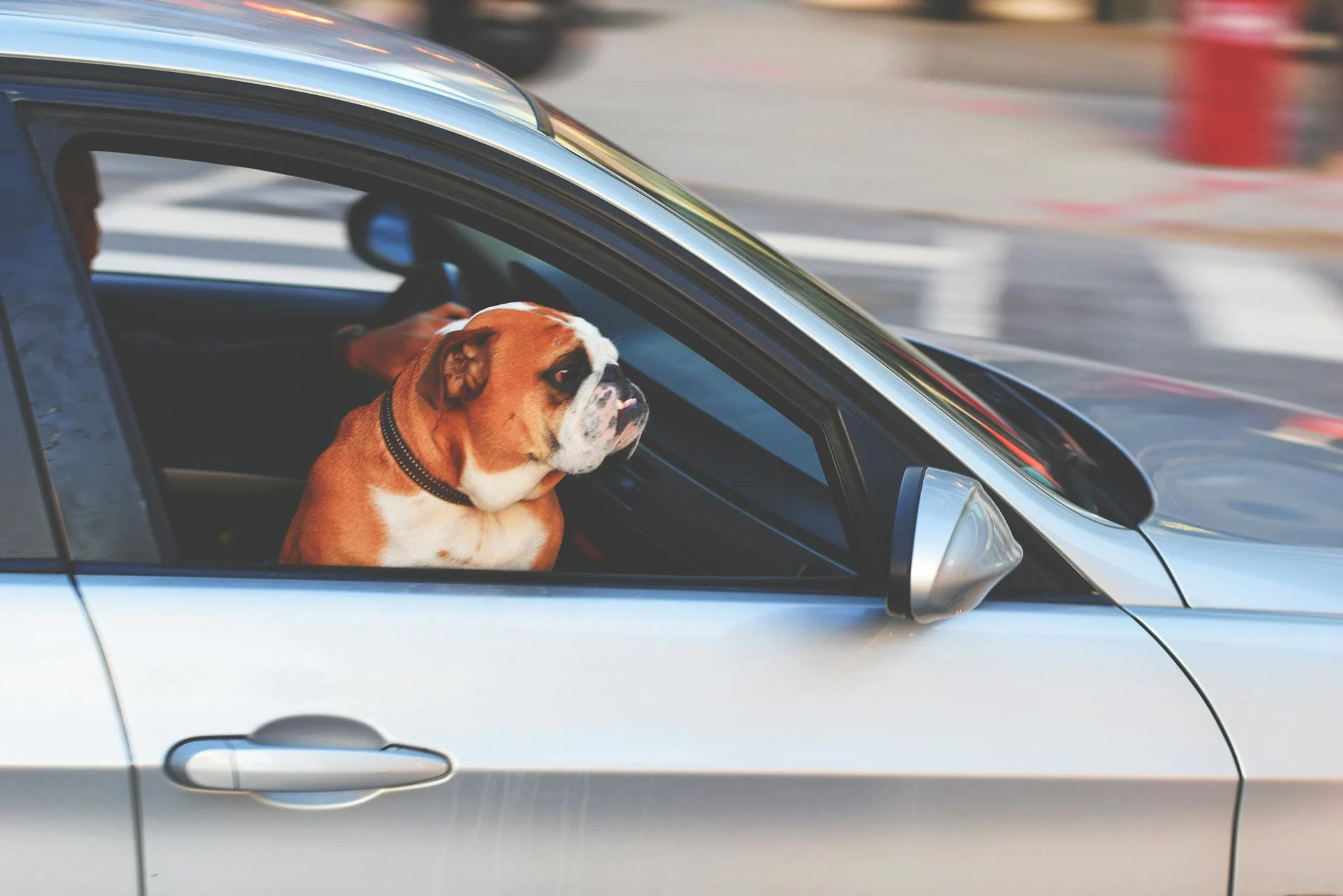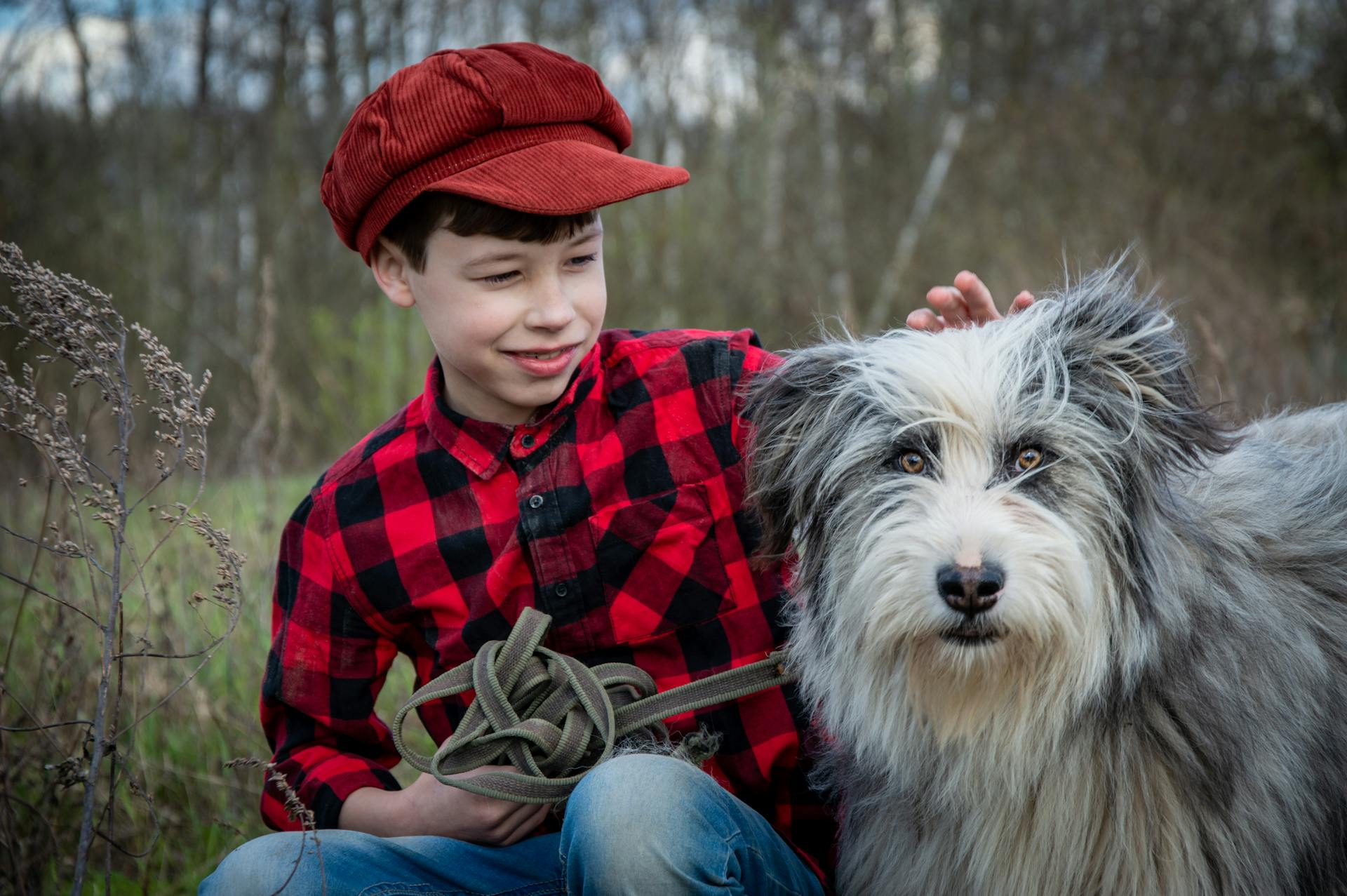
The Old English Sheepdog is a gentle giant, with an average weight of 70-100 pounds and a height of 20-24 inches. They're a large breed, but their laid-back nature makes them a great companion for families.
Their origins date back to the 18th century, when they were bred to herd sheep in England. They're a natural herder, but their friendly demeanor makes them more suited to being a family pet.
Old English Sheepdogs have a distinctive shaggy coat that requires regular grooming to prevent matting. They shed heavily, so be prepared for regular brushing sessions.
Their calm and patient nature makes them a great breed for families with children, and they're also suitable for apartment living due to their low exercise needs.
Discover more: Straight Back German Shepherds
Characteristics
Old English sheepdogs are known for their high affection level, which makes them a great fit for families who want a dog that will be by their side at all times. They're extremely friendly and love people, so be prepared for plenty of snuggles and attention-seeking behavior.
Their friendliness also extends to kids, making them a great choice for families with young children. However, it's worth noting that they may not be as pet-friendly, so if you have other pets in the house, you may want to introduce them slowly and under close supervision.
In terms of exercise needs, old English sheepdogs require moderate exercise to stay happy and healthy. They're not high-energy dogs, but they do need regular walks and playtime to keep them from getting bored or restless.
Here's an interesting read: How Much Exercise Do Border Collies Need
Neck, Topline, Body
The neck of this breed is fairly long and arched gracefully.
A distinctive characteristic of this breed is its topline, which stands lower at the withers than at the loin with no indication of softness or weakness.
The body is rather short and very compact, with a broader rump than shoulders.
Ribs are well sprung and the brisket is deep and capacious, avoiding both slab-sided and barrel-chested appearances.
The loin is very stout and gently arched.
Forequarters
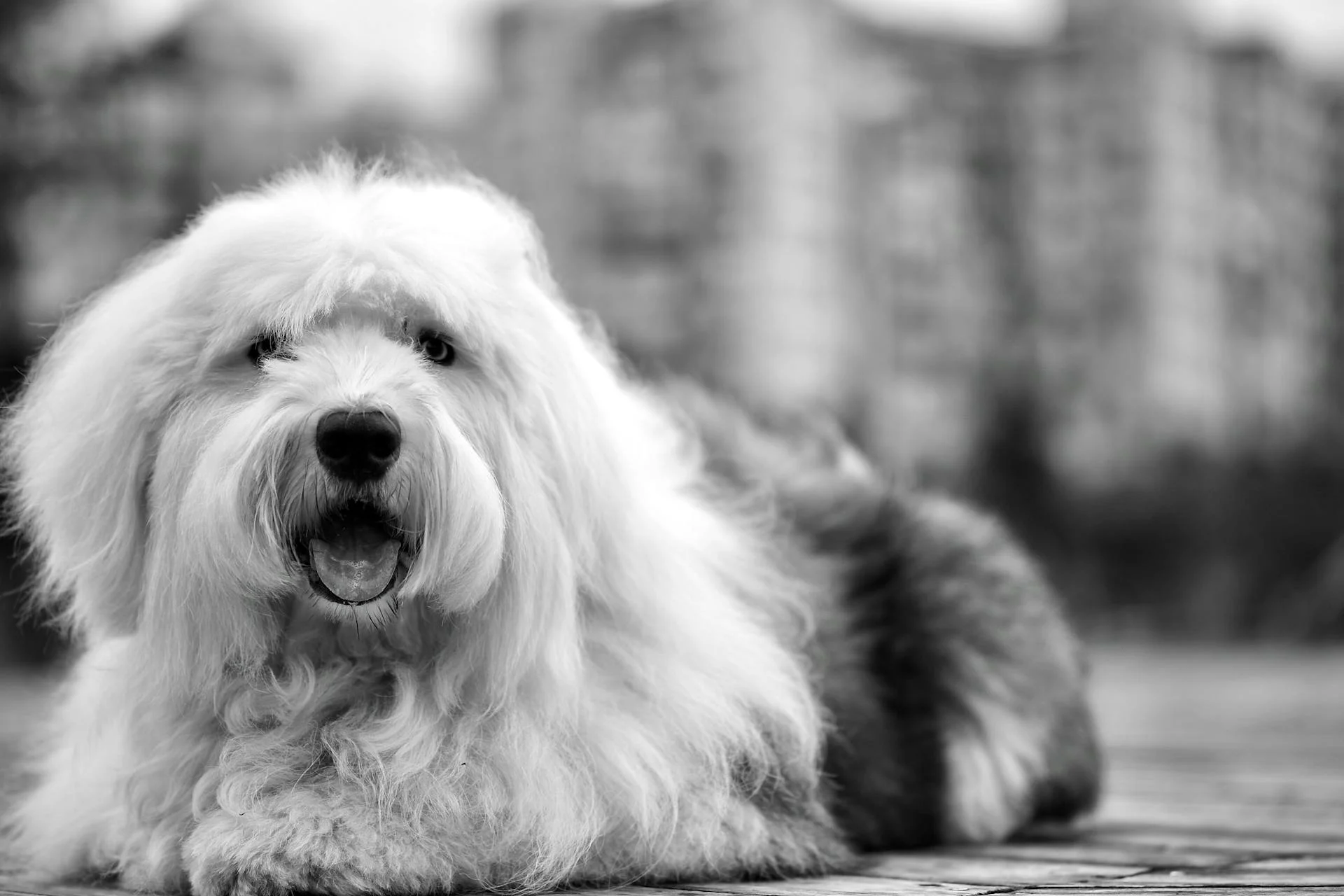
The forequarters of a dog are a crucial aspect of their overall appearance and structure. Shoulders well laid back and narrow at the points are essential characteristics.
The forelegs should be dead straight, which is a notable feature in many breeds. Plenty of bone is also desirable, indicating a strong and sturdy build.
The measurements from the withers to the elbow and from the elbow to the ground are practically the same, which is a key indicator of proper forequarter alignment.
Characteristics
The Old English Sheepdog is a lovable breed with a distinctive coat that requires regular grooming. They have a shaggy, double coat that's a waterproof pile when not removed by grooming or season.
Their coat is moderately coated on the ears and well-covered on the neck and forelegs. The hams are densely coated with a thick, long jacket in excess of any other part.
Grooming is a high maintenance task for this breed, and they need regular brushing to prevent matting. In fact, grooming is so high maintenance that it's almost a full-time job.
For another approach, see: Are Border Collies High Maintenance
The Old English Sheepdog's temperament is friendly and affectionate, making them a great family pet. They're also highly intelligent and fast learners, but can be independent thinkers and may deviate from trained behaviors.
Here's a breakdown of the Old English Sheepdog's characteristics:
Overall, the Old English Sheepdog is a great breed for families who are willing to commit to regular grooming and exercise.
History
The Old English Sheepdog originated in England in the 1700s, and its exact breed details are unknown. They are believed to be a cross between local droving dogs and the Bearded Collie.
Farmers used these dogs as "drover dogs", driving livestock to market and pulling carts and wagons. They were known for their stamina, steadiness, and courage. Owners would often dock their tails to prove they were working dogs, earning them the nickname "bob" or "bobtail."
Here are some key facts about the Old English Sheepdog's history:
- First emerged in England in the 1800s
- Recognized by the American Kennel Club in 1888
- Originally called the "Shepherd's Dog"
- Exported to America and became a popular show dog
History of the Breed
The Old English Sheepdog has a rich and fascinating history that spans over a century. This breed originated in England in the 1800s and was initially used as a "drover dog", driving livestock to market and pulling carts and wagons. Farmers valued their stamina, steadiness, and courage.
The breed's exact pedigree is still debated among experts, but it's thought to have descended from European breeds such as the Scotch Bearded Collie and French Briard. One thing is certain: the Old English Sheepdog is a modern breed that emerged in England in the 1800s.
In its early days, the breed was known for its shaggy fur, which helped it blend in with sheep. Farmers would often dock their tails to prove that they were working dogs, earning them the nickname "bobtail." This practice was also a way to exempt them from local taxes.
The breed was first recognized by the American Kennel Club in 1888 and quickly became a popular show dog and beloved pet. Within 20 years, Old English Sheepdogs had settled into the homes of five of the ten wealthiest American families, including the Vanderbilts and Guggenheims.
A unique perspective: Boston Terrier New England
Here's a brief timeline of the breed's history:
The Old English Sheepdog has come a long way since its early days as a working dog. Today, it's a beloved companion and family pet, known for its affectionate, easygoing, and lovable nature.
1905
In 1905, the Official Standard of the Old English Sheepdog was established, describing a compact and strong dog with a profuse coat.
The body of the dog was to be rather short and very compact, with ribs well sprung and a deep and capacious brisket. The loin should be very stout and gently arched, while the hindquarters should be round and muscular.
The coat was to be profuse and of good hard texture, not straight but shaggy, and free from curl. The undercoat should be a waterproof pile, when not removed by grooming or season.
The breed was described as having a strong compact looking dog, of great symmetry, absolutely free from legginess or weaselness, profusely coated all over. They were also very elastic in their gallop, but in walking or trotting they had a characteristic ambling or pacing movement.
The 1905 Standard also included a scale of points, with the highest points awarded for the body, loins, and hindquarters, which made up 20 points.
Broaden your view: German Shorthaired Pointer Free to Good Home
1927
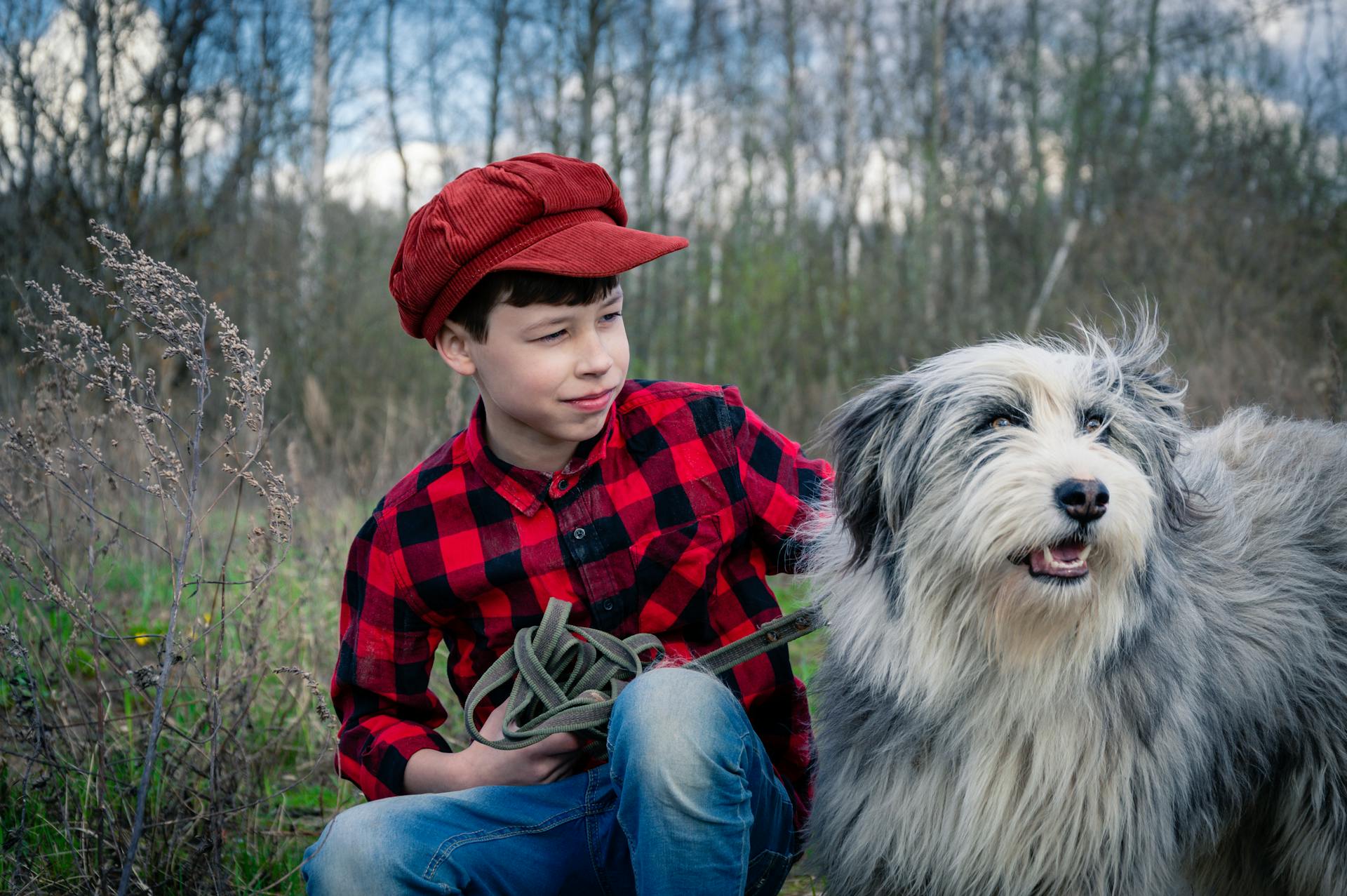
In 1927, Charles Lindbergh made history by becoming the first person to fly solo non-stop across the Atlantic Ocean, landing his Spirit of St. Louis in Paris.
This incredible feat marked a major milestone in aviation and paved the way for future long-distance flights.
1953
1953 was a pivotal year in history, marked by significant events that shaped the world as we know it today. The first commercial jet airliner, the de Havilland Comet, made its maiden flight in 1953.
The United States and the Soviet Union were engaged in a fierce rivalry, with the Soviet Union making a significant breakthrough in the field of nuclear energy. The Soviet Union successfully detonated its first hydrogen bomb in 1953.
The world was also witnessing a cultural shift, with the rise of rock and roll music. Elvis Presley's first single, "That's All Right", was released in 1953.
Recommended read: Are German Shepherds Good for First Time Owners
Care and Wellness
Old English Sheepdogs are known for their great inside manners, so they're not usually a problem when it's time to wind down indoors. They have a friendly demeanor and are not typically seen barking or guarding their territory, but can be protective when necessary.
To keep your Old English Sheepdog happy and healthy, it's essential to watch her diet, provide plenty of exercise, and regularly brush her teeth and coat. They need a high-quality diet appropriate for their age, and feeding them people food is not recommended.
Their thick double-layered coat requires regular maintenance, with daily brushing necessary to keep mats at a minimum and their skin healthy. Brushing their teeth daily is also crucial to avoid problems down the road.
A fresh viewpoint: Dogo Argentino Teeth
Hindquarters
The hindquarters of your horse are a vital part of their overall health and well-being. This area is where their muscles and bones meet, and it's essential to ensure they're in top condition.
A well-developed hindquarters is characterized by a round and muscular build, with well-let down hocks. The metatarses, or the bones in the horse's legs just above the hooves, should be perpendicular to the ground when viewed from any angle.
Care
Taking care of an Old English Sheepdog requires a significant commitment to their grooming needs. They have a thick double-layered coat that needs to be brushed daily, with a focus on preventing mats and tangles.
Brushing their coat daily will help keep their skin healthy and prevent hot spots or red, irritated patches. You'll need to use a comb, pin brush, or slicker brush, and possibly a de-matting rake for stubborn tangles.
Old English Sheepdogs shed heavily year-round, so be prepared for regular vacuuming. They also need regular nail trims, typically every four to six weeks, and their ears should be cleaned weekly.
Bathe your OES about every six to eight weeks, or more often if they spend a lot of time outdoors. Use a mild shampoo and be gentle, as they can be sensitive to harsh chemicals.
Daily brushing also helps prevent dental problems, so aim to brush their teeth daily. This will help prevent issues like bad breath, yellow teeth, and gum disease.
Here's a summary of the regular grooming tasks:
- Brush their coat daily
- Clean their ears weekly
- Bathe every 6-8 weeks
- Trim their nails every 4-6 weeks
- Brush their teeth daily
Health
Old English Sheepdogs are prone to several health issues that can affect their quality of life. Their life expectancy is between 10 to 12 years.
For another approach, see: Average Lifespan of a Boston Terrier
Hip dysplasia is a common problem in Old English Sheepdogs, where the ball and socket of the hip joint don't fit correctly, leading to lameness, pain, and stiffness. Treatments vary depending on the severity but can include weight management, joint supplements, pain medication, and surgery.
Eye disease is another concern, with conditions like cataracts, glaucoma, and progressive retinal atrophy causing blindness if not treated. Entropion is a condition where the dog's eyelid turns inwards, irritating the cornea and causing discomfort.
Dilated cardiomyopathy (DCM) is a heart condition where the heart has trouble pumping blood to the body due to enlargement and weakness. Deafness is also a possibility, especially in all-white puppies, with no treatment available but dogs with hearing issues can still live happy, healthy lives.
Old English Sheepdogs are also at risk for hypothyroidism, an endocrine disease where the thyroid glands don't produce enough thyroid hormone, leading to lethargy, weight gain, and hair loss. Diagnosis is typically by blood test, and treatment is most often daily oral medication.
Regular grooming can prevent health issues like joint problems and infections. Brushing your dog's teeth daily will prevent periodontal disease, which affects 80% of dogs by age two.
Here's an interesting read: How Old Is Too Old to Clip a Dog's Ears?
Breed
The Old English Sheepdog breed has a rich history, dating back to the 1800s in England. They were originally bred to assist cattlemen in driving livestock and sheep to market.
Their shaggy gray and white coat is one of their most distinctive features, and they're also known as "bobtails" due to the practice of docking their tails to prove working status and exempt them from taxes.
Here are some key characteristics of the breed:
- Affectionate, easygoing, and lovable
- Good watchdog with a loud bark
- Bouncy, cheerful, loyal, and enthusiastic
- Lively, with a friendly personality
- Good with children and other pets
- Energetic and playful
Breed Details
The Old English Sheepdog is a breed that's perfect for active families who want a loyal companion. The breed is relatively large, with a height of 21-22 inches and a weight of 60-100 pounds.
Their life expectancy is around 10-11 years, which is a good amount of time to enjoy their loving and gentle nature. They're also relatively low maintenance when it comes to their living situation, as they can thrive in either a town or country setting.
Here are some key details to consider when thinking about bringing an Old English Sheepdog into your family:
- Status: Common
- Life Expectancy: 10 - 11 years
- Weight: 60 - 100 lbs
- Height: 21 - 22" +
- Rare: No
- Coat: Long - Double
- Grooming Requirements: Everyday
- Town or Country: Either
- Minimum Home Size: Large House
- Minimum Garden Size: Large Garden
- Breed Type: Herding
- Size: Large
- Energy Level: Medium
- Exercise Required: Over 2 hours
One thing to keep in mind is that Old English Sheepdogs require a lot of exercise, so you'll need to be prepared to spend at least 2 hours a day engaging them in physical activity.
Weight
As you consider the weight of your new pet, remember that some breeds are naturally heavier than others.
The Cane Corso, for instance, can weigh up to 120 pounds.
While the Cane Corso is a sturdy breed, others like the Greyhound are much lighter, typically weighing between 50-80 pounds.
The weight of your pet will also depend on its size, with larger breeds like the Mastiff often weighing over 200 pounds.
In general, it's essential to consider your lifestyle and living situation when choosing a breed, as some breeds require more space and exercise than others.
A Unique Breed
The Old English Sheepdog is a unique breed that's sure to capture your heart. They're known for their shaggy gray and white coat, which is a distinctive feature of this breed.
One of the most endearing qualities of the Old English Sheepdog is their affectionate nature. They're easygoing, lovable, and make great companions.
Their friendly personality shines through in their lively and bouncy demeanor. They're always up for an adventure and love to play.
But be warned, their herding instincts can kick in, especially when it comes to small children. They might try to herd them around, so it's essential to supervise interactions between kids and your Sheepie.
The Old English Sheepdog is also prone to boredom and separation anxiety when left alone. They need frequent attention from their family and can get into trouble if they don't receive enough stimulation.
Here are some key characteristics of the Old English Sheepdog breed:
- Affectionate, easygoing, and lovable
- Good watchdog with a loud bark
- Bouncy, cheerful, loyal, and enthusiastic
- Lively, with a friendly personality
- Good with children and other pets
- Energetic and playful
On the other hand, they can be strong-willed and difficult to train, so patience and consistency are key. They also don't do well in the heat, so it's essential to provide them with a cool and comfortable environment.
Overall, the Old English Sheepdog is a loyal and trustworthy companion that's sure to bring joy and love into your life.
Adopting or Buying a Dog
If you're interested in bringing an Old English Sheepdog into your family, you'll want to consider adopting or buying from a responsible source.
First and foremost, it's essential to ensure the puppy is healthy and well-cared for. The Old English Sheepdog Club of America recommends purchasing from breeders who raise their dogs in accordance with the AKC standard.
A reputable breeder will provide written instructions on feeding, health, training, and grooming, and guarantee that the puppy is free of hip dysplasia, eye defects, and internal parasites.
The puppy should also be up to date with vaccinations from common diseases and at least eight weeks of age.
Here are some key things to look for in a responsible breeder:
- Free of hip dysplasia, eye defects, and internal parasites
- Up to date with vaccinations from common diseases
- At least eight weeks of age
- Guaranteed against hereditary faults
The OESCA provides referrals to responsible breeders as well as a directory of rescue organizations throughout the U.S.
Temperament and Personality
The Old English Sheepdog is a gentle and active breed that makes a great family dog. They're known for being clownish and bounding goofily when excited, and they have a zest for life while maintaining an even temperament.
Old English Sheepdogs can be protective, giving a distinct bark to head off strangers. However, with proper socialization, they can get along with young children and cats, and even other dogs.
They take their job as professional herders very seriously and love keeping busy, so make sure to provide plenty of opportunities for stimulation. They catch on quickly and can get bored with the same old commands, so mix it up a little during your training sessions.
Training
Training is a crucial aspect of Old English Sheepdog ownership, and with their responsive nature, they can learn quickly with positive reinforcement. They thrive on rewards like treats or love, making training a fun and rewarding experience for both you and your dog.
Old English Sheepdogs are intelligent and alert, making training easier, but they can also be independent thinkers. This means they might come up with their own way of behaving if you're not consistent in your training methods.
To prevent this, it's essential to be a firm leader and practice consistency during exercises. This will help minimize independent thinking and ensure you're the one in charge.
Their natural herding instinct can be a challenge, but you can fulfill this characteristic by playing games like hide-and-seek or Treibball. This will keep your dog engaged and prevent them from trying to herd family members.
Old English Sheepdogs learn quickly, picking up commands like sit, stay, and come in no time. However, their intelligence also means they'll be on to the next command soon, so be prepared for a fun and challenging training experience.
Socialization training is also crucial, especially since Old English Sheepdogs can be nervous around groups of strangers. Include meeting and greeting people in and out of the home from a young age to help them feel more confident and secure.
Related reading: When Will Shiba Inu Hit 1 Cent
Temperament and Personality
Old English Sheepdogs are adaptable, intelligent dogs with an even disposition, and they're not prone to aggression, shyness, or nervousness.
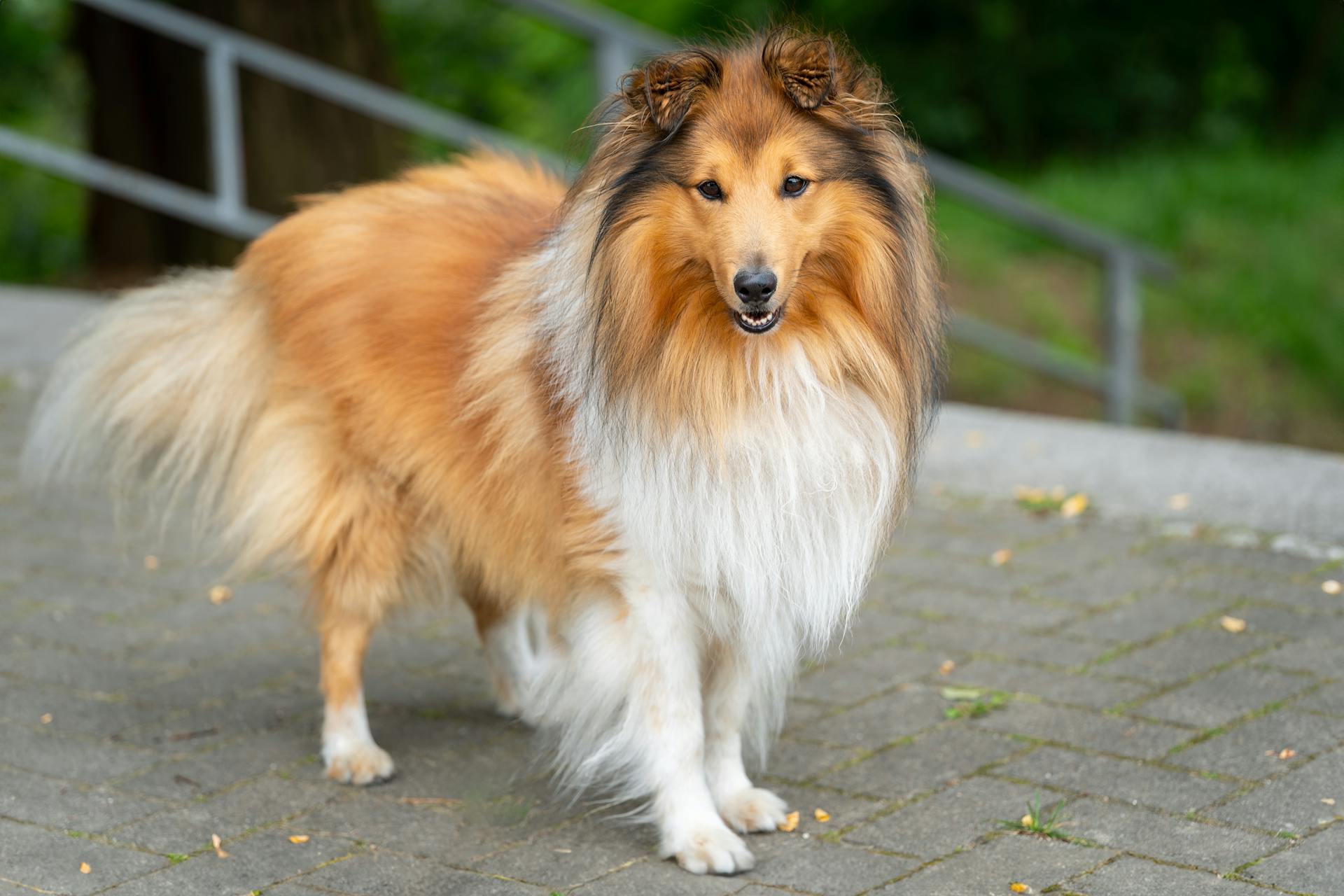
Their lovable and fuzzy appearance belies a wild streak as puppies, but they settle down slowly, taking more than two years to mature.
These dogs are naturally protective of their people and can be wary of strangers, but with socialization, they can learn to get along with anyone.
Old English Sheepdogs are known for their clownish behavior, bounding goofily when excited, and they have a zest for life that's infectious.
They can be protective, giving a distinct bark to head off strangers, but once you're in their zone of trust, they become friendly, loyal, and devoted playmates.
Socialization is key to ensuring they get along with young children, other dogs, and even cats, so it's essential to introduce them to new experiences and people from an early age.
With proper socialization and training, Old English Sheepdogs can thrive in families with children and other pets, and they'll even share their affection freely with their family members.
If this caught your attention, see: Pembroke Welsh Corgi Temperament Protective
Reviews and Resources
Old English Sheepdogs are known for their loving nature, with one owner describing their OES as "sweet, kind and enjoy every moment".
They make great companions and enjoy human attention, with one owner saying their OES "loves meet new friends and get human attention".
Some Old English Sheepdogs can be wary of other animals, with one owner noting their dog "attempts to scare off any animal she sees", although with training and socialization, this can improve over time.
Pictures
Pictures can be a great way to add visual interest to your reviews and make them more engaging.
You can use images from the manufacturer's website, which often provide high-quality product photos.
Including pictures of the product in use can also be helpful, such as a photo of a person wearing the clothing item or using the product.
Product demos and tutorials are also a great way to showcase a product's features and functionality through video.
It's worth noting that some products may have specific image requirements for reviews, such as using a certain type of photo or adhering to a specific size requirement.
Latest Reviews (2)
Old English Sheepdogs are known for their loving nature, with one owner describing their OES as "sweet, kind and enjoy every moment". They thrive on human attention and make great companions.
These dogs are social and love meeting new friends, as one owner mentioned. They're perfect for people who need company and a best friend forever.
Old English Sheepdogs can be wary of other animals, with one owner noting that their dog attempts to scare off any animal she sees. This may take time to overcome, as one owner said their dog is still not fond of their grandmother's dog.
Frequently Asked Questions
Are Old English Sheepdogs good pets?
Old English Sheepdogs are loving family pets that thrive on human attention, making them a great fit for families who can provide plenty of interaction. However, their high social needs require regular attention and exercise.
What is the average price of an Old English Sheepdog?
The average price of an Old English Sheepdog varies by region, ranging from $1,000 to $2,500. Prices tend to be higher on the West Coast due to increased demand.
Do Old English Sheepdogs shed?
Old English Sheepdogs shed, but their shedding is surprisingly average compared to other breeds. However, they still produce a significant amount of long hair that can accumulate on surfaces.
Why are Old English Sheepdogs so expensive?
Old English Sheepdogs are expensive due to their high quality breeding standards and the expertise of reputable breeders. Prices vary based on factors like quality, breeder preference, and competitive rates, so be wary of unusually low prices.
Are Old English Sheepdogs high maintenance?
Old English Sheepdogs require regular grooming to prevent matting and tangling of their long hair, making them a moderate to high-maintenance breed. Daily brushing is essential to keep them happy and healthy.
Sources
- https://www.thesprucepets.com/old-english-sheepdog-4427883
- https://oldenglishsheepdogclubofamerica.org/history/akc-brand-standard/
- https://greenvalleyah.com/client-resources/breed-info/old-english-sheepdog/
- https://be.chewy.com/dog-breed/old-english-sheepdog/
- https://www.omlet.us/breeds/dogs/old_english_sheepdog/
Featured Images: pexels.com
